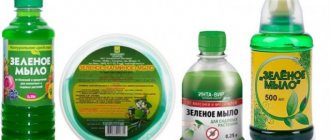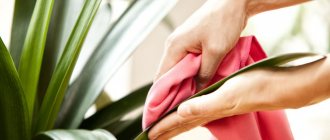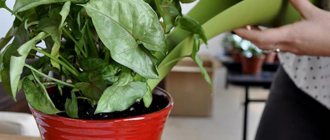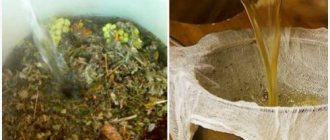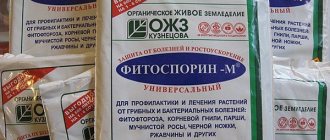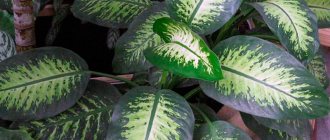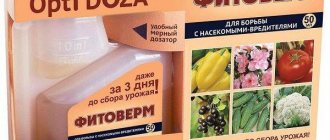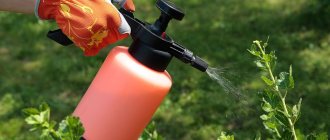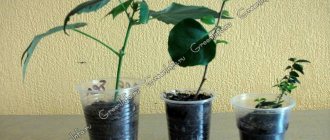In pest control, folk remedies are, of course, good, but not always effective.
At the initial stages, when there are still few insects and they have not had time to reproduce, you can try to do without chemicals. However, when the scale of the damage becomes critical, it is impossible to do without special drugs. And here insecticides for indoor plants come to the aid of gardeners. How to use them correctly and which means are the most effective, but at the same time have a gentle effect on flowers? Article on the topic: Intavir - instructions for use!
What are insecticides?
Insecticides are chemical or biological agents that kill insect pests. Biological agents are not so dangerous. Before using any insecticide, you need to test it on one plant. If after 24 hours the condition of the flower has not worsened, then you can use the product on all plants of this variety. To prevent plants from becoming addicted, it is recommended to alternate insecticides for indoor plants.
Treat all plants, being sure to follow safety precautions. It is necessary to wear at least a respirator when using insecticides, since the drug is very quickly absorbed into the blood through the lungs. Read the instructions carefully and follow them when using the drug.
Shchitovka
Scale insects also appear on house plants, and each type of scale insect can infect a specific type of plant. The palm scale insect parasitizes the shoots of palm trees. There are also cactus, pink, ivy, Californian, laurel, and oleander scale insects. Often scale insects appear on lemons or orchids. A characteristic feature of these pests is the shell that protects their body. In this regard, it is quite difficult to fight scale insects.
The false scale insect, which does not have a waxy shell, poses a huge danger to plants. The females of these pests grow up to 5 mm in length, and they have neither legs nor wings, unlike males. Females are distinguished by the fact that their body is covered with a convex shield, which can have different shapes, both round and oval.
These parasites prefer to be found on any part of the plant, both on the stems and on the back of the leaves. There is also a hemispherical scale insect, which is slightly larger in size and volume. Plants such as ferns, asparagus and myrtle are affected by these pests. Below is the appearance of some pests of indoor plants.
Fighting scale insects (pests of indoor plants). Part 1
Pests of indoor plants
Midges or sciarids (fungus gnat)
Small insects, they appear in pots in winter, when flowers are watered less. Adult midges lay their eggs in the ground and hatch into larvae that eat the roots. For prevention, water the plants as the flower requires, do not water very often. Fertilize plants with tea leaves, it contains tannin, which destroys sciarid larvae and eggs. Be sure to replant the flower once every 3 years.
How to save flowers from midges . Replant the plant in new soil, first thoroughly washing the roots of the flower. Stick 6 matches into the ground with sulfur heads. Water the pots, then the sulfur will be absorbed into the soil and will destroy the sciarid larvae. You can also water the flowers with a solution of soap or potassium permanganate. Since midge larvae mainly grow in moisture, reduce watering. This method is suitable for succulents and cacti. Cover the top of the soil with ash or calcined sand. When replanting the plant, pour boiling water over the soil.
Mealybug
People also call the pest “hairy louse” because the insect secretes a waxy substance similar to cotton wool. The photo shows that adult scales are oval in shape and slightly crimson in color. Adult larvae gather on young shoots, from the bottom of leaves and buds, they suck out the juice, which is why the flowers grow very slowly.
Adult mealybugs move quickly, their eggs are placed in a pouch that resembles a piece of cotton wool. The pest produces honeydew, on which sooty fungus then appears. Periodically inspect the flowers and water them systematically, as the bugs start in dry places.
How to get rid of mealybugs . When you see a diseased plant, isolate it and tear off the infected leaves. If the plant is just sick, you can soak a cotton swab in soapy water and wipe the leaves, as well as the gaps between the trunk and leaves. Then spray with a solution of 10 g of green soap per 1 liter of water. After a week, repeat spraying. And after another 7 days, spray again. You can spray with infusion of tobacco or garlic, or a decoction of cyclamen. Spray the plant with insecticides or lepidocide.
House aphids
Aphids are small insects that suck plant sap with their proboscis. There are 4,000 species of aphids. Pests have a size of 2-3 mm, but they can be larger in size up to 5-6 mm. They come in red, green, brown and black. Aphids can be easily seen; they are found on flowers and leaves. In flowers affected by aphids, the shoots become deformed, the leaves dry out, and shrink. Honeydew, a secretion from aphids, is also visible.
It is recommended to ventilate the room and provide good lighting to the plants. Damaged leaves need to be plucked off. Flowers need to be carefully inspected. Water the plant with a shower.
How to get rid of aphids . If you see an infected plant, separate it from healthy ones. Treat the flower with a soap solution. Spray the plant regularly. If there are a lot of aphids, then the plant needs to be treated with insecticides.
Spider mite
Ticks are very small insects up to 1 mm. Red spider mites appear on indoor flowers; they are located on the underside of the leaves.
Adult females can lay hundreds of eggs over their lifetime. The eggs lie for up to 5 years, after which ticks appear from them, so you need to fight them. In diseased plants, small white dots are visible on the leaves, after which the leaves dry out and fall off. Some types of mites lay thin webs.
How to protect flowers from spider mites . You can spray with water, then pollinate the flowers with pyrethrum powder or ground sulfur. For control, plants are sprayed with Intavir, Derris, Fitoverm, Fufan, Actellik and Karbofos.
Whitefly
This is a small yellowish moth that carries viral diseases. Its larvae appear at the bottom of the leaf as small grains; they have an oval-oblong shape and are light green in color. Insects suck the juice, the leaves turn yellow and fall off. They leave a sugary discharge, and soon a sooty fungus appears on them.
How to save flowers from whiteflies . You can try to catch adult butterflies by hanging flypaper near the flowers. Wash the leaves of the diseased plant thoroughly to remove larvae and eggs. Spraying with a solution of 10 g of green soap per 1 liter of water helps. Do this 3-5 times a day.
Then the plant rests for 6 days. Afterwards spraying is repeated. Garlic solution helps a lot. The whitefly is destroyed with a solution of 3 cm³ of “Nicotine sulfate” per 1 liter of water, “Parathion” 1 cm³ per 1 liter of water, sprayed once every 3 days.
Grape elephant beetle
The beetle has a long proboscis, eats leaves, and the larvae are found in the ground. Most beetles appear on cyclamens and primroses. The creamy larvae are up to 2.5 cm long and eat tubers and roots.
The beetle loves to settle on maiden beauty (fuchsia), begonia, ram (primrose), and cyclamen. The indoor flower fades, its leaves droop and fall off. You can determine that an adult beetle is present on plants by holes in the leaves, damaged edges, and wilted buds.
How to destroy the "grape elephant" . The land is treated with insecticides: Fitoverm, Aktelik, Aktara. Spread a 2 cm layer of gravel on the ground to prevent the beetles from reaching the ground. Beetles do not fly or swim, so you can place the diseased plant in a pot of water.
Drosophila. These are very small brown midges, about 2-3 mm, that appear on rotten plants. They transmit pathogens. They can appear on spoiled food products. Ventilating the room in winter helps. The soil is watered with any available insecticide.
Shields
Small insects up to 5 mm, covered with a shield, they feed on sap.
How to save flowers from scale insects . Isolate sick flowers. Wipe the leaves with a cotton swab lubricated with an insecticide made from 2 ml of Actellik per 1 liter of water.
Afterwards treat the flowers with soap or tobacco solution. Then wash off the solution. At the end of the procedure, re-spray the flowers and the soil with insecticide. Wrap the plants in plastic. After 30 min. remove the film. After 3 days, rinse the flowers with warm water.
Thrips
Very small insects on the inside of the leaf. White dots are visible on the outside of the leaf. First, yellow or whitish spots and stripes appear on the flowers, after which they merge. The leaves wither and fall. The flowers are falling. If there are a lot of thrips, you will see "silver" parts on the plant.
How to deal with thrips. You need to wipe the flowers with a soap solution. Then wash the plant in the shower. Dissolve 2 ml of Fitoverma in a glass of water. Treat the flower, then put a plastic bag on it, remove it after 24 hours. Or dilute 2.5 ml of Vermitek in a bucket of water (10 l). Spray the flower, put on the bag, you can remove it after 24 hours.
Nematode
These are white worms 0.5 mm long, found in the ground, feeding on juices. Nematodes that form cysts burrow into the roots and attach to them. After fertilization, the body of such females becomes a cyst, that is, a reservoir with eggs. Free nematodes can crawl along the roots. Root-knot nematodes crawl into rhizomes, they secrete galls - thick nodules on the roots, in which they live and reproduce.
How to save flowers from nematodes . The diseased plant is isolated. The earth is heated for 10 minutes. in a water bath at a temperature of +55C. In order to kill nematodes, place 1 tablet of “Dekaris” in 1 liter of water and water the flower 4 times.
Fighting methods
Many novice gardeners are wondering how to deal with pests of indoor plants. The answer to this is important, since insects multiply rapidly, time must not be wasted.
There are different ways to help get rid of pests:
- mechanical;
- biological;
- chemical;
- folk
If pests of indoor plants are correctly identified, and measures to combat them will be effective.
Mechanical
You need to start with the measures that are safest for humans, especially since they often help a lot. Before starting work, you should disinfect and sharpen your tools. All damaged leaves and shoots are cut off, and the cut areas should be sprinkled with activated carbon.
Bugs and visible larvae are selected manually: scale insects, slugs, caterpillars. Leaves with pests such as aphids can be wiped with a cotton pad. A contrast shower and spraying with water helps get rid of pests living on the green parts of the plant.
It is also possible to immerse the above-ground parts of the affected plant in warm water with a small amount of detergent. In this case, it is advisable to place the pot in a plastic bag and tie it at the top so that the soil does not lock.
Biological
Biological control measures consist of controlling diseases and pests with insecticidal and phytoncidal plant preparations. Most often used:
- "Fitoverm";
- "Agrovertin";
- "Iskra-Bio".
Herbal preparations should be made the main assistants in the fight against pests and diseases of indoor plants. On the one hand, they are environmentally friendly, and on the other hand, they bring real benefits.
Treatment with herbal preparations is carried out in the first half of the day, preferably in the absence of other inhabitants of the apartment. In the evening, before going to bed, the room in which the treatment was carried out is thoroughly ventilated. Individual plants are isolated with plastic film.
Special sprayers are used to spray affected plants. For pollination or dusting, powdered preparations are poured into small gauze bags, which are then shaken over the plant.
Chemical
Chemicals are used in extreme cases. They are considered the most effective, but require strict adherence to safety measures:
- It is necessary to remove all food products from the premises in advance. In warm weather, it is better to treat the affected plant with pesticides in the fresh air, in winter - with the window open.
- During chemical treatment, you should wear a gown and a protective gauze bandage or respirator.
- During chemical treatment, you should not smoke or eat.
- At the end of the chemical operation, you need to thoroughly wash your hands, face and the place where the plant was standing at the time of spraying or dusting with warm water and soap.
- To avoid leaf burn, treated plants should not be placed in the sun until they are completely dry.
- Treated plants should be cared for in the same way as healthy ones.
- All toxic solutions must be prepared in advance.
- Chemicals should be stored in containers with tight-fitting lids, out of the reach of children.
Popular and effective remedies for pests of indoor plants:
- "Karbofos";
- "Chlorophos";
- "Syphos";
- "Trichlorometaphos";
- "Pyrethrum";
- "Decis";
- "Fury."
Folk
If indoor plant pests appear, treatment can be carried out with time-tested folk remedies. For this purpose, decoctions and infusions are prepared from the following plants:
- yarrow;
- chamomile;
- dandelion;
- marigolds;
- nettle;
- garlic;
- Luke;
- peels of oranges, tangerines, lemons.
These environmentally friendly and harmless plants can effectively destroy harmful insects. Steamed citrus peels can be buried in the soil. Insects don't like their smell.
An infusion of tobacco, stove ash, a solution of potassium permanganate, furatsilin or soda works well. To prevent the liquid from immediately draining from the plants, laundry soap is added to it.
How to use insecticides to protect indoor plants?
Bitoxibacillin . Biological insecticide. It is used without looking at the growth phase of the plant. The difference between this drug and others is its “live” composition. It contains no toxins and contains protein crystals and microbial spores. Sold as a powder that must be dissolved in some water, mixed and the rest of the water added. The water should be about 20 degrees. It is recommended to add 2 tbsp. spoons of milk powder per 10 liters of solution or 0.5 liters of skim milk per bucket of solution (10 liters). The composition is used within 3 hours after creation; it is not stored. The drug is slightly toxic. Price 25 g - 25 rub.
Actofit is a biologically active drug that kills thrips, aphids, mites, and herbivorous pests. Gnawing insects die 8 hours after spraying, and sucking insects die after 16 hours.
Lepidocide . Biological insecticide, destroys various caterpillars, moths. Bioinsecticides do not accumulate in plants. Price 4 ml - 25 rub.
Fitoverm. A biological product created by microorganisms present in the soil. It is used to kill aphids, mites, thrips and leaf-eating caterpillars. Gently spray the leaves with fresh solution. Ticks and other pests stop eating only after 3-4 hours. They die completely after 3-5 days. The drug is moderately toxic. Price 4 ml - 14.4 rubles.
Inta-Vir . Destroys aphids, thrips, spider mites, whiteflies. Place 1 tablet in a bucket of water (10 l) and spray the leaves. But not all pests can be killed, so it is better to dip the leaves in the solution. You can dissolve 2 tablets in a 10 liter bucket of water. In the same way as for previous drugs, they are processed in protective clothing. When the plants are blooming, the product should not be used. The price of 8 g of the drug is 10 rubles.
Tsvetofos . To poison the scale insects, you must first carefully wipe off the “cotton wool” from the plants with a cotton swab dipped in a soap solution, and then spray it with “Tsvetofos” aerosol.
Aktellik . Destroys a whole complex of pests that eat leaves or suck out juices, such as mites, whiteflies, sawflies, scale insects, aphids, and weevils. To spray indoor plants, you need to dilute a 2 ml ampoule in half a glass of water, the solution has a very strong smell, and then dilute it with water to 1 liter.
The solution is good for 24 hours after preparation. Spray the entire plant, then ventilate the room. If there are pests, then it is worth repeating the procedure after 10 days. Moderately dangerous. When using it, you need to wear special clothing, goggles, a respirator, and gloves. Afterwards you need to wash your hands and face with soap. The price of a 5 ml ampoule is 25 rubles.
Aktara . The insecticide is active, killing aphids, whiteflies, bedbugs, leafminers, flea beetles, spider mites, and scale insects. You can buy Aktary vacuum bags, they contain 4 g. The package of the drug is diluted in 5 liters of water at a temperature of 25°C. Then the diseased plants are sprayed, and then the room is ventilated. The insecticide can be addictive in insects, which is why it needs to be alternated with other drugs.
To use it, you need to wear a respirator and gloves. The drug is sold in packages of 4, 40 and 250 g, which contain granules, they are almost odorless and easy to dissolve in water. The price of 1 sachet with 4 g is 100 rubles.
Bazudin . Provides intestinal and contact effects. Used to destroy sciarid larvae and other pests. It contains diazinon. It is sold in the form of granules of 30 g. The composition is added to the soil, and also sprinkled on the surface of the earth when pests appear. 1.5 g scattered per 1 square. meter. Price 30 g - 35 rub.
Vertimek . Protects against spider mites and thrips. Price 2 ml - 35 rub.
Decis . Copes well with aphids, thrips, and scale insects. You need to throw 1 ampoule into a bucket of water (10 l). The drug is very toxic. Price 1 g - 44 rubles.
Karate Zeon . Protects against ticks and other insects.
Karbofos . Sold as 10% water soluble powder and 10% emulsion concentrate. Very toxic. Price 30 g - 40 rub.
Keltan - 20% emulsion concentrate. Used against spider mites.
Fufan . It has a contact and intestinal effect, that is, insects die when the product enters the intestines. Destroys almost all pests of indoor flowers. 5 ml of Fufan is added to half a bucket of water (5 l). Can be processed 3 times at intervals of 2 weeks. The drug is moderately toxic.
Nicotine sulfate . From tobacco plants. This is a brown-cherry liquid composition that has the smell of tobacco. It dissolves perfectly in water. To 1 liter of solution you need to add 4-5 g of green soap.
Parathion . Used to kill whiteflies. May cause serious poisoning in humans and domestic animals.
Hairy aphid
This type of aphid is also called mealybugs. They are one of the most dangerous insects for plants. As a rule, they can be found on the underside of leaves. Their presence is indicated by a cobweb-like white coating, as well as the presence of a sticky liquid.
These insects are distinguished by a high degree of fertility. Female mealybugs lay eggs in miniature formations that resemble balls of cotton wool. After a certain time, fairly mobile larvae emerge from these lumps, which are then distributed throughout the plant. Fighting them requires an instant reaction. The sooner you start fighting this pest, the greater the chance of saving the plant.
Mealybug is a pest of domestic flowers. Signs of infection, methods of control
Plant insecticides
Henbane black . The flower is poisonous because it contains alkaloids. The most deadly are the roots and leaves of the annual plant. They are harvested early in spring or autumn. Two-year-old henbane is completely poisonous and is collected when it blooms. Henbane must be hung to dry. 100 g of crushed henbane is poured into 1 liter of water. If dried leaves and rhizomes are available, then pour 50 g into 1 liter of water. Leave for 12 hours, then filter. Pour 4 g of soap per 1 liter of infusion. Dried henbane powder is used to pollinate other plants.
Marigolds . An infusion against aphids is prepared from them. Dry marigolds are ground, poured into a bucket of warm water, left for 48 hours, and filtered. Add 40 g of soap. Spray the flowers.
Datura common . It protects against aphids, herbivorous bugs, copperheads, spider mites, and cabbage moths. When flowering, the above-ground part or leaves, buds, and flowers are torn off. Dry by hanging in the air. 100 g of dry crushed henbane is poured into 1 liter of water and left for 12 hours. Pour 4 g of soap into the strained infusion.
Onions help get rid of suckers, spider mites, and aphids. The scales are removed from the onion, 20 g are poured into 1 liter of water. Flowers are watered three times every 5 days.
Garlic destroys ticks, aphids, sawflies, and lungworts. Grind 100 g of garlic, add 1 liter of water and mix. Add water to 2 liters. Then, when spraying, 0.3 liters of the resulting composition are further diluted with 10 liters of water. Flowers are processed after 3 days.
Dalmatian and Caucasian daisies . It destroys aphids, leaf-eating caterpillars and mites. The substances do not have a harmful effect on humans, mammals and birds, but kill insects. The baskets of Caucasian chamomile are robbed when it blooms. The stems, inflorescences, and leaves of the Dalmatian plant are collected. They are poured in a layer of 2 cm and dried, stirred every day. The dry parts of chamomile are ground into powder.
For Dalmatian chamomile, use 1 part of the inflorescences and mix with 2 parts of dust or chalk, kaolin. For Caucasian chamomile, take 1 part of the flower and 1 part of the filler: chalk. Then pour 200 g of powder into a small amount of water and pour out a bucket of water (10 l). Afterwards the plants are sprayed.
Common yarrow . Destroys aphids, spider mites, copperheads, leaf-eating caterpillars, thrips. When the plant blooms, the above-ground part is cut off. Yarrow is dried and crushed. 80 g of dried grass is scalded with boiling water, poured with 1 liter of water, and left for 36 hours.
Creeping bitterweed . Kills aphids and ticks. At the beginning of flowering, bittersweet is collected, dried, and crushed. Add 1 liter of water to 200 g of mustard, then wait 2 days.
White fool
White podurs are hopping insects that can be found in potted houseplants. They differ:
- An elongated body on which sparse hairs grow.
- Having 3 pairs of legs.
- Having a long mustache.
- Prefers moist conditions.
The diet of these pests includes the remains of plant components, as well as a living root system. If you do not pay attention to these parasites in time and do not destroy them, they can lead to the death of indoor plants.
Potassium permangantsovka
Treatment with a solution of potassium salt of permanganic acid is the simplest and fastest way to disinfect soil. Three grams of potassium permanganate are dissolved in a ten-liter bucket of water to form a faint pink suspension. The liquid is carefully poured onto the soil to be disinfected, centimeter by centimeter. Potassium permanganate is also used to treat pots and containers for seedlings.
Manganese, when it gets into the ground, saturates it with useful substances - it becomes a fertilizer.
Potassium permanganate is not able to destroy all pathogens, so this method is considered ineffective. To enhance soil disinfection, the container with the treated soil is covered with cellophane film and kept for a week. Under such conditions, pathogenic microflora die, and the soil is saturated with moisture and microelements.
Spider mite
Many indoor plant lovers are familiar with this common and quite dangerous pest. This is a tiny insect that can only be detected with a magnifying glass. Colonies of these insects are found on the underside of leaves. Spider mites prefer warm and dry air. Under such conditions, the insect reproduces at a tremendous rate.
You can determine that a plant is infected with spider mites:
- By light spots that are visible in places where pests live.
- By the presence of the finest cobwebs that cover plants.
Chinese roses, geraniums and palm trees suffer quite a lot from the invasion of spider mites, which suck the juices out of them.
Codling moths, moths, copperheads, sawflies, small caterpillars
Preventive spraying is carried out during the flowering period, during the summer of butterflies: every 5 days.
Sagebrush
Steam a kilogram of bitter herb with a bucket of boiling water. After cooling, strain.
Red hot pepper
Prepare an infusion from 1 kg of fruit and 10 liters of water, strain, and put in a cool, dark place. To spray, dilute 500 ml of liquid with ten liters of water.
Onion
Chop 100 g of onion, add 1 liter of cold water, leave without boiling for 24 hours.
Fungus gnats (sciarids)
These insects are also called scyriads. These are not large flies, up to half a centimeter long, that fly around indoor plants. Sexually mature individuals carry the larvae of various pests, which infect plants. The scyriads themselves lay eggs in the root system of plants, which causes great harm to the plants, since white larvae emerge from the eggs and feed on the root system. The result of their vital activity is dead indoor plants.
Calcination
Firing is carried out in the oven. To do this, place the soil in a fireproof container or baking sheet, first covering it with parchment. The soil is thoroughly poured with boiling water and covered with foil on top. The optimal thickness of the soil to be heated is 10 cm. The oven is heated, but not higher than 90 degrees, otherwise toxins will form in the soil and all beneficial microflora will be destroyed. The process lasts about half an hour, then the earth is left to cool and become saturated with oxygen.
Baking the soil is a variant of calcination. The earth is evenly distributed over the baking sleeve and closed with flexible brackets. Further actions correspond to the calcination process. In this case, moisture from the soil does not evaporate, but rather completely saturates and saturates it.
Steam bath
Hot steam treatment kills eggs, insect larvae and all sources of plant disease. Disinfection is carried out in a pressure cooker or in a regular saucepan.
In the first case, water is poured into the pressure cooker, and a container with soil is placed above its surface. The thickness of the soil should not exceed 10 cm. The trays with soil are covered with foil and closed with a lid with the valve slightly open. After the water boils, leave for 20-30 minutes.
In the second case, the soil is placed in a sieve, the bottom of which is covered with gauze. Bring water to a boil in a saucepan and place a colander over it so that it does not come into contact with moisture. The soil is steamed for 1.5 hours, stirring regularly to ensure uniform heating.
A steam bath will not only get rid of pathogens, but will also saturate the soil with moisture.
